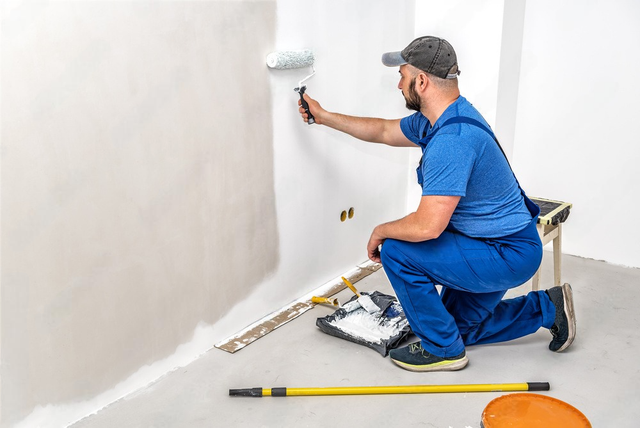Checking Out the Various Sorts Of Paint: A Guide for each Task
Exploring the numerous sorts of paint is vital for attaining the preferred result in any kind of project. From water-based options that supply benefit to oil-based paints recognized for their longevity, each option has its advantages. Specialized paints can include distinct textures or coatings, while green choices cater to those looking for sustainability. Comprehending these distinctions can considerably affect the success of a painting endeavor. What factors should one take into consideration when making the best option?
Recognizing Paint Kinds: Water-Based vs. Oil-Based
Paint types can markedly affect a task's outcome, and understanding the distinctions in between water-based and oil-based paints is vital for educated decision-making. Water-based paints, typically referred to as latex paints, are made up of water as the main solvent. They dry swiftly, discharge fewer unpredictable organic compounds (VOCs), and are easy to clean up with soap and water. This makes them a popular selection for indoor applications and atmospheres where air quality is a worry.
In comparison, oil-based paints make use of organic solvents, providing a durable, shiny coating ideal for surfaces revealed to damage, such as trim and closets. They take longer to completely dry, call for mineral spirits for cleaning, and have a more powerful smell. corpus christi tx paint shop. Selecting between these two types relies on the specific needs of the job, thinking about variables such as desired finish, application environment, and simplicity of maintenance. Each type has distinctive advantages and restrictions, guiding the option procedure
The Finish Matters: Choosing Between Matte, Satin, and Gloss
When choosing a paint surface, the choice between matte and shiny options significantly impacts both aesthetics and capability. Matte coatings offer a refined, non-reflective appearance that can hide surface imperfections, while glossy surfaces provide durability and ease of cleaning. Comprehending the benefits and factors to consider of each can aid in making a notified decision for any kind of painting task.
Matte Complete Advantages
Many house owners discuss the merits of numerous surfaces, matte paint supplies distinctive benefits that make it a preferred selection for both interior and exterior applications. Among the key advantages of matte coating is its capacity to conceal surface blemishes, developing a smoother look on walls. This top quality is especially advantageous in older homes or areas with irregular surfaces. In addition, matte paint absorbs light instead of mirroring it, which can boost the visual of a space by supplying a much more sophisticated and muted look. Additionally, matte surfaces are frequently easier to repair than glossier options, as they can blend extra flawlessly when used over existing paint. On the whole, matte paint is a superb choice for those looking for a fine-tuned and elegant finish.
Shiny Complete Considerations
A glossy surface can drastically modify the perception of a space, offering a smooth and reflective quality that boosts both color vibrancy and light within a space. This coating is frequently preferred for high-traffic areas and surface areas like bathroom and kitchens, where resilience and simplicity of cleansing are crucial. Nevertheless, its reflective nature can highlight blemishes on wall surfaces, making correct surface area preparation important. Glossy paints likewise tend to reveal fingerprints and smudges quicker, requiring routine upkeep. Furthermore, lighting plays a significant function; in intense atmospheres, a shiny surface might create glow, impacting the overall visual. Subsequently, cautious consideration of the details application and setting is very important when selecting a shiny finish for any type of task.
Specialized Paints: When to Use Distinctive or Chalk Paint
Specialized paints, such as textured and chalk paint, offer special visual and functional advantages that can improve various surface areas. Distinctive paint is suitable for creating depth and dimension on walls, hiding blemishes while including a three-dimensional feel. It is especially advantageous in high-traffic locations where resilience and aesthetic passion are important.

Both kinds of specialized paints can transform rooms, yet choosing the ideal one relies on the wanted result and surface area needs. Textured paint may fit larger locations, while chalk paint can renew smaller sized things, showcasing imagination and individual design in any task.
Outdoor Paints: Protecting Your Surfaces From the Elements
Exterior paints are vital for guarding surfaces versus numerous climate problems. Understanding their climate resistance features, proper surface preparation requirements, and efficient application methods can substantially boost longevity and performance. This section will lay out crucial factors to consider for picking and utilizing outdoor paints efficiently.
Weather Resistance Features
Weather resistance is a vital function of outdoor paints, as it figures out just how well surfaces can withstand the harsh elements of nature. High-quality outside paints are developed to resist damages from UV rays, moisture, and temperature fluctuations. UV resistance warranties shades stay vivid with time, protecting against fading and discoloration. Wetness resistance secures against mold and mildew, which can jeopardize the honesty of surface areas. In addition, paints with excellent temperature level resistance can contract and increase without breaking, preserving their protective qualities. When picking outdoor paints, it is essential to take into consideration these weather resistance features, as they add to the longevity and sturdiness of coloured surface areas, making sure they stay visually pleasing and practical regardless of exposure to the aspects.
Surface Area Prep Work Demands
Appropriate surface area preparation is an essential step in attaining the very best outcomes with outdoor paints. To guarantee optimal adhesion and sturdiness, surface areas have to be extensively cleansed, getting rid of oil, dust, and mildew. This can be achieved utilizing a pressure washing machine or a scrub brush with a suitable cleaning option. Once cleansed, surfaces need to be inspected for any peeling or flaking paint, which should be scratched away to create a smooth structure. Repairing any type of cracks or holes is also crucial, as these can permit dampness infiltration. Additionally, fining sand harsh areas promotes far better paint attachment. Lastly, applying a primer suited for outside use can enhance the paint's performance, assuring a lasting surface that endures the components. Appropriate prep work is key to an effective outdoor painting job.
Application Strategies Tips
While applying exterior paints, it is necessary to utilize effective methods that assure surface areas are well-protected against the aspects. Initially, select the appropriate day for painting; reduced humidity and moderate temperatures enhance bond and drying. Prepping the surface area completely-- cleansing, fining sand, and priming-- makes sure far better paint bond and toughness. Utilizing high-grade brushes or rollers can offer a smoother coating, while spray painting might cover large areas efficiently. Applying paint in slim, also coats prevents drips and runs. It is a good idea to adhere to supplier instructions pertaining to drying out times in between coats. Finally, validate correct ventilation during application to help with drying and lessen direct exposure to fumes. These strategies greatly enhance the long life and performance of outside paint.
Eco-Friendly Options: Low-VOC and Zero-VOC Paints
As click here consumers end up being progressively knowledgeable about the environmental effect of their options, zero-voc and low-voc paints have actually become preferred options. These paints are created to contain fewer volatile natural substances (VOCs), which are chemicals that can evaporate right into the air and add to air pollution and wellness issues. Low-VOC paints commonly contain a limited quantity of VOCs, while zero-VOC paints have minimal degrees, making them safer for both exterior and indoor usage.
The benefits of making use of low-VOC and zero-VOC paints extend beyond ecological considerations; they likewise boost indoor air quality, decreasing the danger of respiratory system issues and allergies. Several manufacturers currently offer a range of shades and finishes in eco-friendly alternatives, making it much easier for customers to find appropriate products for their tasks. By deciding for these paints, individuals can contribute to a healthier setting while still accomplishing the visual they desire in their areas.
Devices and Methods for a Flawless Application
Accomplishing a flawless paint application calls for the right devices and techniques, which can greatly enhance the outcome. Selecting the suitable brush or roller is vital; brushes work well for edges and complex locations, while rollers cover bigger surfaces efficiently. Making use of top notch products guarantees far better paint distribution and decreases streaks. For perfect results, surface prep work is critical. This includes cleaning, fining sand, and priming surface areas to advertise adhesion.
Strategy likewise plays a considerable role. The "W" technique with a roller helps to evenly disperse paint, while long, smooth strokes with a brush prevent noticeable lines. Functioning in areas enables far better control and blending. In addition, using thin layers is more effective to thick layers, lowering the risk of drips and uneven textures. Keeping a wet edge throughout application aids achieve smooth modifications between areas. By incorporating these strategies and devices, one can accomplish a professional and refined finish.
Tips for Maintaining and Caring for Your Painted Surfaces
Proper maintenance and treatment of painted surface areas can greatly extend their life-span and protect their appearance. Normal cleaning is important; making use of a soft cloth or sponge with mild soap and water can remove dust and dust without harming the paint. It is a good idea to stay clear of rough cleansers or rubbing pads, as these can damage the surface. Furthermore, using a fresh layer of paint every few years can protect and renew the shade against wear.
For outside surfaces, checking for signs of peeling or fading frequently is very important. Immediately resolving any kind of concerns stops more damage. In locations vulnerable to dampness, such as bathrooms, using mold-resistant paint and making sure correct ventilation can assist maintain the integrity of the paint. Making use of protective coatings can shield versus UV rays and stains, making certain that painted surfaces stay dynamic and attractive for years to come, inevitably boosting the general aesthetic of the space.
Visual Regularly Asked Inquiries
Can I Mix Different Kind of Paint With Each Other?
Mixing various sorts of paint is typically not recommended, as it can result in concerns like poor adhesion, irregular structure, or unforeseen chain reaction. It's best to make use of compatible paints for suitable outcomes and resilience.

Just how Do I Properly Shop Leftover Paint?
To appropriately save leftover paint, seal the container securely, label it with the date and shade, and keep it in a great, completely dry place away from direct sunlight and severe temperatures for suitable conservation.
What Is the very best Means to Take Care Of Extra Paint?
The most effective method to throw away extra paint is to inspect local policies, as several locations have actually designated hazardous waste centers. Take into consideration giving away useful paint to neighborhood organizations or colleges for their projects.
Exactly How Can I Inform if Paint Is Still Excellent to Utilize?
To figure out if paint is still great, examine its smell, shade, and uniformity. If it appears separated, has an undesirable odor, or shows significant changes in structure, it's most likely no more usable.
Exist Age Restrictions for Acquiring Paint Products?
In several regions, there are no certain age limitations for acquiring paint items. Some shops might call for customers to be at least 18 years old, especially for products including solvents or dangerous materials.
Paint types can markedly influence a task's end result, and recognizing the differences in between water-based and oil-based paints is necessary for educated decision-making. Water-based paints, commonly referred to as latex paints, are composed of water as the primary solvent. In comparison, oil-based paints use organic solvents, giving a long lasting, shiny coating suitable for surfaces exposed to tear and use, such as trim and closets. Specialty paints, such as distinctive and chalk paint, offer unique visual and sensible benefits that can improve numerous surface areas. In areas prone to moisture, such as washrooms, utilizing mold-resistant paint and guaranteeing correct air flow can help keep the honesty of the paint.